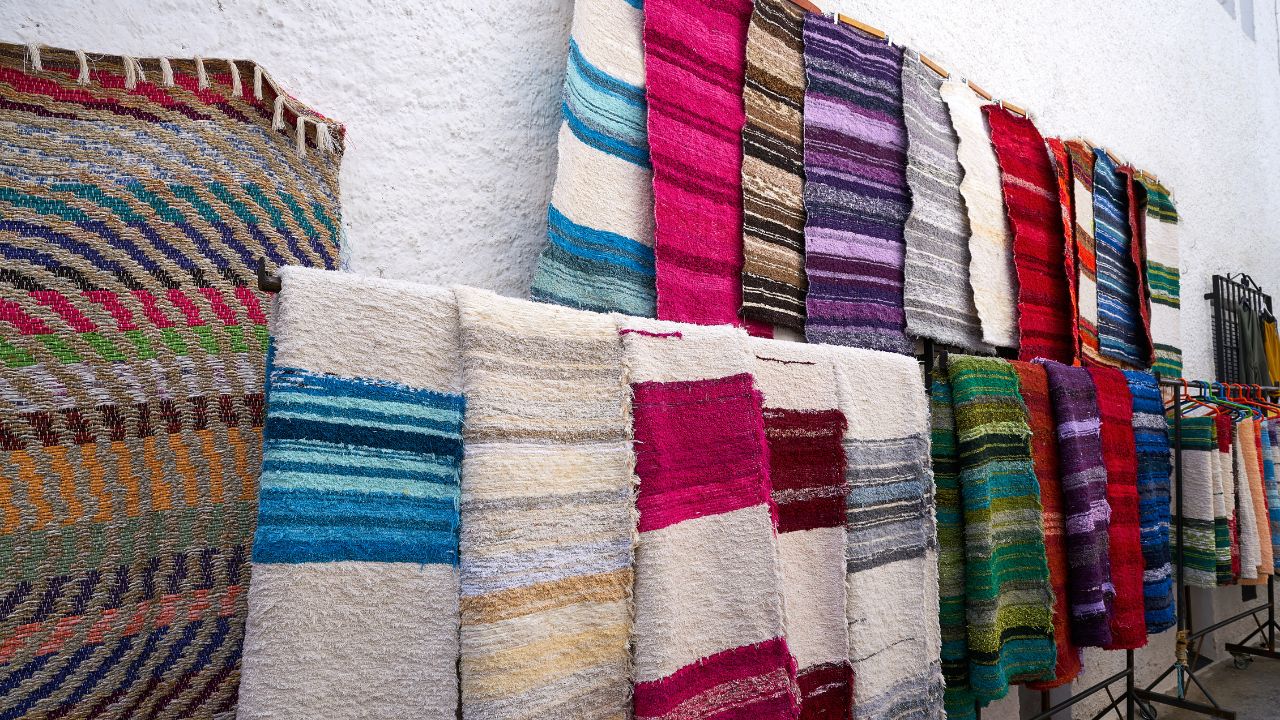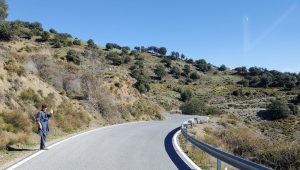After part 1 of our Road Less Travelled exploration of the eastern flanks of La Alpujarra, the tourist route, we were keen to see what laid on the opposite side of Trevélez – the side that the caterpillar coaches can’t reach beyond in a day’s tour. What secrets would we find, hidden along the Road Less Travelled? We loved Bibón, Pampaneira and Capileira – their existence reliant on their mountain hosts, who offer them refuge so they can make their living from the land. Yet we were curious about what was the ‘other side’.
Coming out of Trevélez on the western edge of the valley was great, as feelings about a place can often change when we can see it from another angle. One view is never a true perspective – only a first impression. And the view from the western bank of the mountain was great. To see all three layers of the town and the snow covered Sierras towering over it was lovely. Not a ghost town tucked up high in the mountains; a thriving industrial area that paradoxically maintains a balance between its Jamón production and creating a homely, authentic community.
Given that the Road Less Travelled out of Trevélez is not a tourist route, the road’s quality surprised us. Until we remembered that the Jamón delivery vans would make the journey this way to reach eastern Spain distribution routes. A big investment in their infrastructure.
Following the A-4130, Scoobie twisted, turned, rose and fell like a rollercoaster ride, although we were too enthralled by the ever-changing landscape to feel any sense of travel-sickness. Each mountain crevice offered a different vista to our greedy eyes. Locals going about their business, mostly oblivious to the excitable passengers passing by. Well, except this friendly chap. Would love to have stopped to chat and find out his story. Alas my imagination had to make one up!
Every turn another village; some smaller settlements, others slightly larger affairs. Each one of the main villages though, we were amused to notice, had four common features.
- Obviously for pueblo blancos – every building was white!
- They all had a church with different style steeples
- A disco! Yes you read right! A disco. Well the young people need something to do on a Friday night!
- They all had a helicopter pad.
Now you may be forgiven for thinking that the mountain descendants of the Moors and Christian battles of the 15 Century had suddenly come into financial abundance, although no! The helicopter pads were purely medicinal. So remote are these villages and so windy are the roads, that if anyone falls seriously ill, they would not make the nearest Hospital in time, which I guess would be Motril or Ugíjar – both of which are miles away. So these helipads are for the Air Ambulance.
We made a little stop at Bérchules, which offered tremendous views over the valley; terraced, green and lush with spring signs dominant for as far as the eye could see. These regions are gifted with their solitude by clean mountain air, fresh, relatively unpolluted rainfall and concentrated sunshine. We really got the feel here that the land is treated in a sacred way; they love it and it loves them in return. Sad that more communities around the world cannot respect that same value. Still that is the way of the world, always a yin and a yang.
Along the route there are plenty of Miradors to soak up the stunning views and feel the air against your face – or was the draft from Dave the Drone on one of his practise flights? I have to say that my camera could in NO way capture the scene that my eyes were absorbing. It’s a bit like the Grand Canyon in US, if you have ever been. Just one of those occasions where adjectives and camera images, even with the latest technology simply do not do it justice. You’ll just have to take my word for it – it was beautiful. I often struggle with trying to capture the perfect shot that conveys what I’m experiencing so I can share it. Sometimes though, you just need to feel it and put the camera down.
The final stop, for a well-deserved bit of lunch, was Válor, which was a lovely, warm town. Below you could see the more populated Ugíjar, which seemed like a pretty large community with schools, hospitals and more commerce than we’d seen in the last two days. And this was where we left the La Alpujarra route or so we thought! So much more fun was to be had in Almocita and Padules on the furthest reaches of the Sierra’s, although that’s for another time.
Over lunch we reflected on what we’d experience this day compared to our explorations the previous day. It was only 43km and took us no more than 90 minutes, although what struck us about this part of the La Alpujarra was that there was little or no tourist trade – just the odd café bar and may be a restaurant, a post office and a very noisy van, tooting for 30 mins as he called to the inhabitants to buy up the contents of his carriage. The artisans that we saw on the western side were non-existant on this Road Less Travelled. Except what you get in return for your petrol consumption is scenery to blow your mind. And actually, I really liked this side of the valley, offering a far more authentic way of life and pretty much no traffic. For me, there was no preference – just ‘different’ and I’m really glad we followed the whole route. This is a stunning road very suitable for motorhomes and great for motorbikes too. Feed your soul, your imagination and feast your eyes on the region that is La Alpujarra – you’ll not be disappointed. Karen.







Hi,
Wow I once visited those places by car. I have just bought a motorhome but never dreamed it would go up mountain roads. So I was quite excited to read your blog, how difficult is it on these narrow roads ? How do you decide before hand what is do able? Sorry for the beginner type questions but I’m still at the stage of worrying if I will get stuck!
Hi Greg, thanks for getting in touch and no apology needed – just the sort of questions we love to get. How exciting that you’ve got a moho now – what did you choose? It wasn’t difficult at all up through the whole of La Alpujarra – given that Trevelez is a hub for Jamon production, the roads are used to having lorries on them and it’s on the tourist trail, so we knew we’d be ok. We normally judge a road by, if there’s a campsite or wild spot on http://www.searchforsites.co.uk or Camperstop App, then it must be ok for motorhomes to get up there. We’ve been on some pretty hairy roads over the last year and it is a bit of an adventure at times, although depending on the size of your rig, you are normally ok. I tend to look at the map and if it’s a yellow road, it will be fine. If it’s a white one, then we’ll assess it when we get there. Another rule of thumb we use is if a lorry or a coach can get up it, then we’ll be fine too. We find that we just sometimes need to live beyond our fear although apply some savvy rules to keep us safe. Once you’re on the road your confidence will grow by the day. We got into a ‘situation’ on Saturday and I ended up having to drive Scoobie up a mountain and turn him round, as we’d parked up for lunch in a spot that did some damage to his undercarriage and getting out was as tricky as getting into the spot. Doing a five point turn on a bendy road with traffic, on my own was scary, although I’ve done it now and I just kept calm and did it as I had no other choice. So confidence does build over time. Hope that helps. Karen x
Thank you for that Karen. I will check out the app and the website as we hope to go to Scotland for Easter and try some French Aires later in the year. The van we got is a Hymer Exsis-t 588. Its 6.95 long and a bit narrower than some at 2.22. i was worried it was too long to go to “interesting” mountain type places.
All the best with your travels. I will continue to read your blog for inspiration.
Greg.